+ Open data
Open data
- Basic information
Basic information
| Entry | Database: PDB / ID: 6w32 | ||||||
|---|---|---|---|---|---|---|---|
| Title | Crystal structure of Sfh5 | ||||||
 Components Components | Phosphatidylinositol transfer protein SFH5 | ||||||
 Keywords Keywords | SIGNALING PROTEIN | ||||||
| Function / homology |  Function and homology information Function and homology informationphosphatidylinositol transfer activity / endoplasmic reticulum membrane / metal ion binding Similarity search - Function | ||||||
| Biological species |  | ||||||
| Method |  X-RAY DIFFRACTION / X-RAY DIFFRACTION /  SYNCHROTRON / SYNCHROTRON /  SAD / Resolution: 2.9 Å SAD / Resolution: 2.9 Å | ||||||
 Authors Authors | Gulten, G. / Khan, D. / Aggarwal, A. / Krieger, I. / Sacchettini, J.C. / Bankaitis, V.A. | ||||||
| Funding support |  United States, 1items United States, 1items
| ||||||
 Citation Citation |  Journal: Elife / Year: 2020 Journal: Elife / Year: 2020Title: A Sec14-like phosphatidylinositol transfer protein paralog defines a novel class of heme-binding proteins. Authors: Khan, D. / Lee, D. / Gulten, G. / Aggarwal, A. / Wofford, J. / Krieger, I. / Tripathi, A. / Patrick, J.W. / Eckert, D.M. / Laganowsky, A. / Sacchettini, J. / Lindahl, P. / Bankaitis, V.A. | ||||||
| History |
|
- Structure visualization
Structure visualization
| Structure viewer | Molecule:  Molmil Molmil Jmol/JSmol Jmol/JSmol |
|---|
- Downloads & links
Downloads & links
- Download
Download
| PDBx/mmCIF format |  6w32.cif.gz 6w32.cif.gz | 188.3 KB | Display |  PDBx/mmCIF format PDBx/mmCIF format |
|---|---|---|---|---|
| PDB format |  pdb6w32.ent.gz pdb6w32.ent.gz | 150.3 KB | Display |  PDB format PDB format |
| PDBx/mmJSON format |  6w32.json.gz 6w32.json.gz | Tree view |  PDBx/mmJSON format PDBx/mmJSON format | |
| Others |  Other downloads Other downloads |
-Validation report
| Summary document |  6w32_validation.pdf.gz 6w32_validation.pdf.gz | 1.4 MB | Display |  wwPDB validaton report wwPDB validaton report |
|---|---|---|---|---|
| Full document |  6w32_full_validation.pdf.gz 6w32_full_validation.pdf.gz | 1.4 MB | Display | |
| Data in XML |  6w32_validation.xml.gz 6w32_validation.xml.gz | 37.6 KB | Display | |
| Data in CIF |  6w32_validation.cif.gz 6w32_validation.cif.gz | 48.9 KB | Display | |
| Arichive directory |  https://data.pdbj.org/pub/pdb/validation_reports/w3/6w32 https://data.pdbj.org/pub/pdb/validation_reports/w3/6w32 ftp://data.pdbj.org/pub/pdb/validation_reports/w3/6w32 ftp://data.pdbj.org/pub/pdb/validation_reports/w3/6w32 | HTTPS FTP |
-Related structure data
| Similar structure data |
|---|
- Links
Links
- Assembly
Assembly
| Deposited unit | 
| ||||||||
|---|---|---|---|---|---|---|---|---|---|
| 1 | 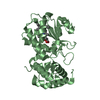
| ||||||||
| 2 | 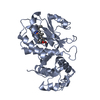
| ||||||||
| 3 | 
| ||||||||
| Unit cell |
|
- Components
Components
| #1: Protein | Mass: 35727.680 Da / Num. of mol.: 3 Source method: isolated from a genetically manipulated source Source: (gene. exp.)  Strain: YJM789 / Gene: SFH5, SCY_3146 / Production host:  #2: Chemical | Has ligand of interest | N | |
|---|
-Experimental details
-Experiment
| Experiment | Method:  X-RAY DIFFRACTION / Number of used crystals: 1 X-RAY DIFFRACTION / Number of used crystals: 1 |
|---|
- Sample preparation
Sample preparation
| Crystal | Density Matthews: 3.5 Å3/Da / Density % sol: 64.85 % |
|---|---|
| Crystal grow | Temperature: 291 K / Method: vapor diffusion, sitting drop / pH: 4.2 Details: 0.1 M KSCN, 0.1 M Na-citrate (pH 4.2), 24% PEG 4000 |
-Data collection
| Diffraction | Mean temperature: 100 K / Serial crystal experiment: N | ||||||||||||||||||||||||||||||
|---|---|---|---|---|---|---|---|---|---|---|---|---|---|---|---|---|---|---|---|---|---|---|---|---|---|---|---|---|---|---|---|
| Diffraction source | Source:  SYNCHROTRON / Site: SYNCHROTRON / Site:  APS APS  / Beamline: 23-ID-D / Wavelength: 1.5498 Å / Beamline: 23-ID-D / Wavelength: 1.5498 Å | ||||||||||||||||||||||||||||||
| Detector | Type: DECTRIS PILATUS3 S 6M / Detector: PIXEL / Date: Jun 25, 2017 | ||||||||||||||||||||||||||||||
| Radiation | Protocol: SINGLE WAVELENGTH / Monochromatic (M) / Laue (L): M / Scattering type: x-ray | ||||||||||||||||||||||||||||||
| Radiation wavelength | Wavelength: 1.5498 Å / Relative weight: 1 | ||||||||||||||||||||||||||||||
| Reflection | Resolution: 2.9→29.33 Å / Num. obs: 32843 / % possible obs: 99.6 % / Redundancy: 6.9 % / CC1/2: 0.996 / Rmerge(I) obs: 0.157 / Rpim(I) all: 0.064 / Rrim(I) all: 0.17 / Net I/σ(I): 10.2 | ||||||||||||||||||||||||||||||
| Reflection shell | Diffraction-ID: 1
|
- Processing
Processing
| Software |
| ||||||||||||||||||||||||||||||||||||||||||||||||||||||||||||||||||||||||||||||||||||||||||||||||||||||||||||||||||||||||||||||||||||||||||
|---|---|---|---|---|---|---|---|---|---|---|---|---|---|---|---|---|---|---|---|---|---|---|---|---|---|---|---|---|---|---|---|---|---|---|---|---|---|---|---|---|---|---|---|---|---|---|---|---|---|---|---|---|---|---|---|---|---|---|---|---|---|---|---|---|---|---|---|---|---|---|---|---|---|---|---|---|---|---|---|---|---|---|---|---|---|---|---|---|---|---|---|---|---|---|---|---|---|---|---|---|---|---|---|---|---|---|---|---|---|---|---|---|---|---|---|---|---|---|---|---|---|---|---|---|---|---|---|---|---|---|---|---|---|---|---|---|---|---|---|
| Refinement | Method to determine structure:  SAD / Resolution: 2.9→29.324 Å / SU ML: 0.47 / Cross valid method: THROUGHOUT / σ(F): 0.21 / Phase error: 33.61 SAD / Resolution: 2.9→29.324 Å / SU ML: 0.47 / Cross valid method: THROUGHOUT / σ(F): 0.21 / Phase error: 33.61
| ||||||||||||||||||||||||||||||||||||||||||||||||||||||||||||||||||||||||||||||||||||||||||||||||||||||||||||||||||||||||||||||||||||||||||
| Solvent computation | Shrinkage radii: 0.9 Å / VDW probe radii: 1.11 Å | ||||||||||||||||||||||||||||||||||||||||||||||||||||||||||||||||||||||||||||||||||||||||||||||||||||||||||||||||||||||||||||||||||||||||||
| Displacement parameters | Biso max: 156.83 Å2 / Biso mean: 81.4977 Å2 / Biso min: 30.8 Å2 | ||||||||||||||||||||||||||||||||||||||||||||||||||||||||||||||||||||||||||||||||||||||||||||||||||||||||||||||||||||||||||||||||||||||||||
| Refinement step | Cycle: final / Resolution: 2.9→29.324 Å
| ||||||||||||||||||||||||||||||||||||||||||||||||||||||||||||||||||||||||||||||||||||||||||||||||||||||||||||||||||||||||||||||||||||||||||
| LS refinement shell | Refine-ID: X-RAY DIFFRACTION / Rfactor Rfree error: 0
|
 Movie
Movie Controller
Controller



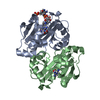
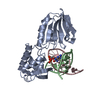

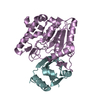
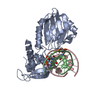
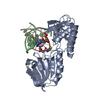
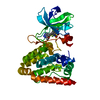
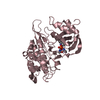
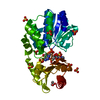
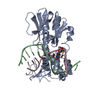
 PDBj
PDBj

